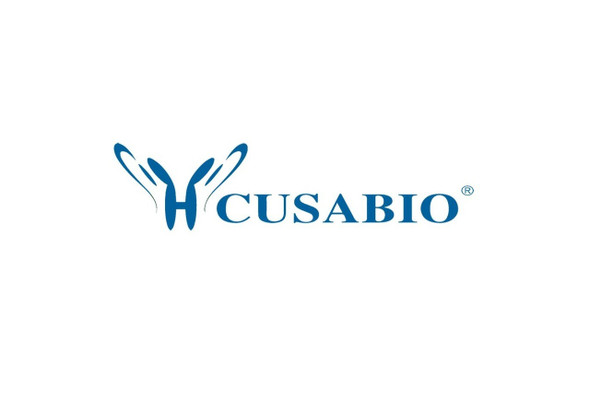Cusabio Human Recombinants
Recombinant Human Nucleoside diphosphate kinase, mitochondrial (NME4) | CSB-EP015889HU
- SKU:
- CSB-EP015889HU
- Availability:
- 13 - 23 Working Days
Description
Recombinant Human Nucleoside diphosphate kinase, mitochondrial (NME4) | CSB-EP015889HU | Cusabio
Alternative Name(s): Nucleoside diphosphate kinase D
Gene Names: NME4
Research Areas: Signal Transduction
Organism: Homo sapiens (Human)
AA Sequence: SWTRERTLVAVKPDGVQRRLVGDVIQRFERRGFTLVGMKMLQAPESVLAEHYQDLRRKPFYPALIRYMSSGPVVAMVWEGYNVVRASRAMIGHTDSAEAAPGTIRGDFSVHISRNVIHASDSVEGAQREIQLWFQSSELVSWADGGQHSSIHPA
Source: E.coli
Tag Info: N-terminal GST-tagged
Expression Region: 1-187aa
Sequence Info: Full Length
MW: 44.3 kDa
Purity: Greater than 90% as determined by SDS-PAGE.
Relevance: Major role in the synthesis of nucleoside triphosphates other than ATP. The ATP gamma phosphate is transferred to the NDP beta phosphate via a ping-pong mechanism, using a phosphorylated active-site intermediate. Through the catalyzed exchange of gamma-phosphate between di- and triphosphonucleosides participates in regulation of intracellular nucleotide homeostasis. Binds to anionic phospholipids, predominantly to cardiolipin; the binding inhibits its phosphotransfer activity. Acts as mitochondria-specific NDK; its association with cardiolipin-containing mitochondrial inner membrane is coupled to respiration suggesting that ADP locally regenerated in the mitochondrion innermembrane space by its activity is directly taken up via ANT ADP/ATP translocase into the matrix space to stimulate respiratory ATP regeneration. Proposed to increase GTP-loading on dynamin-related GTPase OPA1 in mitochondria. In vitro can induce liposome cross-linking suggesting that it can cross-link inner and outer membranes to form contact sites, and promotes intermembrane migration of anionic phosphoplipids. Promotes the redistribution of cardiolipin between the mitochondrial inner membrane and outer membrane which is implicated in pro-apoptotic signaling.
Reference: "nm23-H4, a new member of the family of human nm23/nucleoside diphosphate kinase genes localised on chromosome 16p13." Milon L., Rousseau-Merck M.-F., Munier A., Erent M., Lascu I., Capeau J., Lacombe M.-L. Hum. Genet. 99:550-557(1997)
Storage: The shelf life is related to many factors, storage state, buffer ingredients, storage temperature and the stability of the protein itself. Generally, the shelf life of liquid form is 6 months at -20?/-80?. The shelf life of lyophilized form is 12 months at -20?/-80?.
Notes: Repeated freezing and thawing is not recommended. Store working aliquots at 4? for up to one week.
Function: Major role in the synthesis of nucleoside triphosphates other than ATP. The ATP gamma phosphate is transferred to the NDP beta phosphate via a ping-pong mechanism, using a phosphorylated active-site intermediate. Through the catalyzed exchange of gamma-phosphate between di- and triphosphonucleosides participates in regulation of intracellular nucleotide homeostasis
Involvement in disease:
Subcellular Location: Mitochondrion intermembrane space, Peripheral membrane protein, Mitochondrion matrix
Protein Families: NDK family
Tissue Specificity: Widely distributed. Found at very high levels in prostate, heart, liver, small intestine, and skeletal muscle tissues, and in low amounts in the brain and in blood leukocytes.
Paythway:
Form: Liquid or Lyophilized powder
Buffer: If the delivery form is liquid, the default storage buffer is Tris/PBS-based buffer, 5%-50% glycerol. If the delivery form is lyophilized powder, the buffer before lyophilization is Tris/PBS-based buffer, 6% Trehalose, pH 8.0.
Reconstitution: We recommend that this vial be briefly centrifuged prior to opening to bring the contents to the bottom. Please reconstitute protein in deionized sterile water to a concentration of 0.1-1.0 mg/mL.We recommend to add 5-50% of glycerol (final concentration) and aliquot for long-term storage at -20?/-80?. Our default final concentration of glycerol is 50%. Customers could use it as reference.
Uniprot ID: O00746
HGNC Database Link: HGNC
UniGene Database Link: UniGene
KEGG Database Link: KEGG
STRING Database Link: STRING
OMIM Database Link: OMIM










